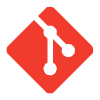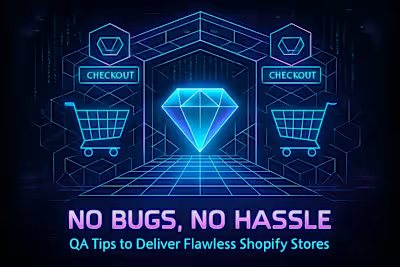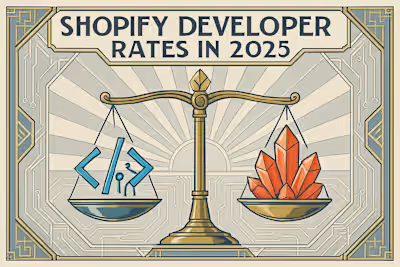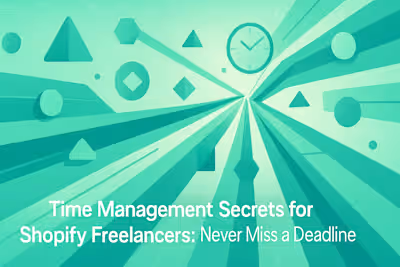New Hire Checklist: Onboarding Your Shopify Developer for Success
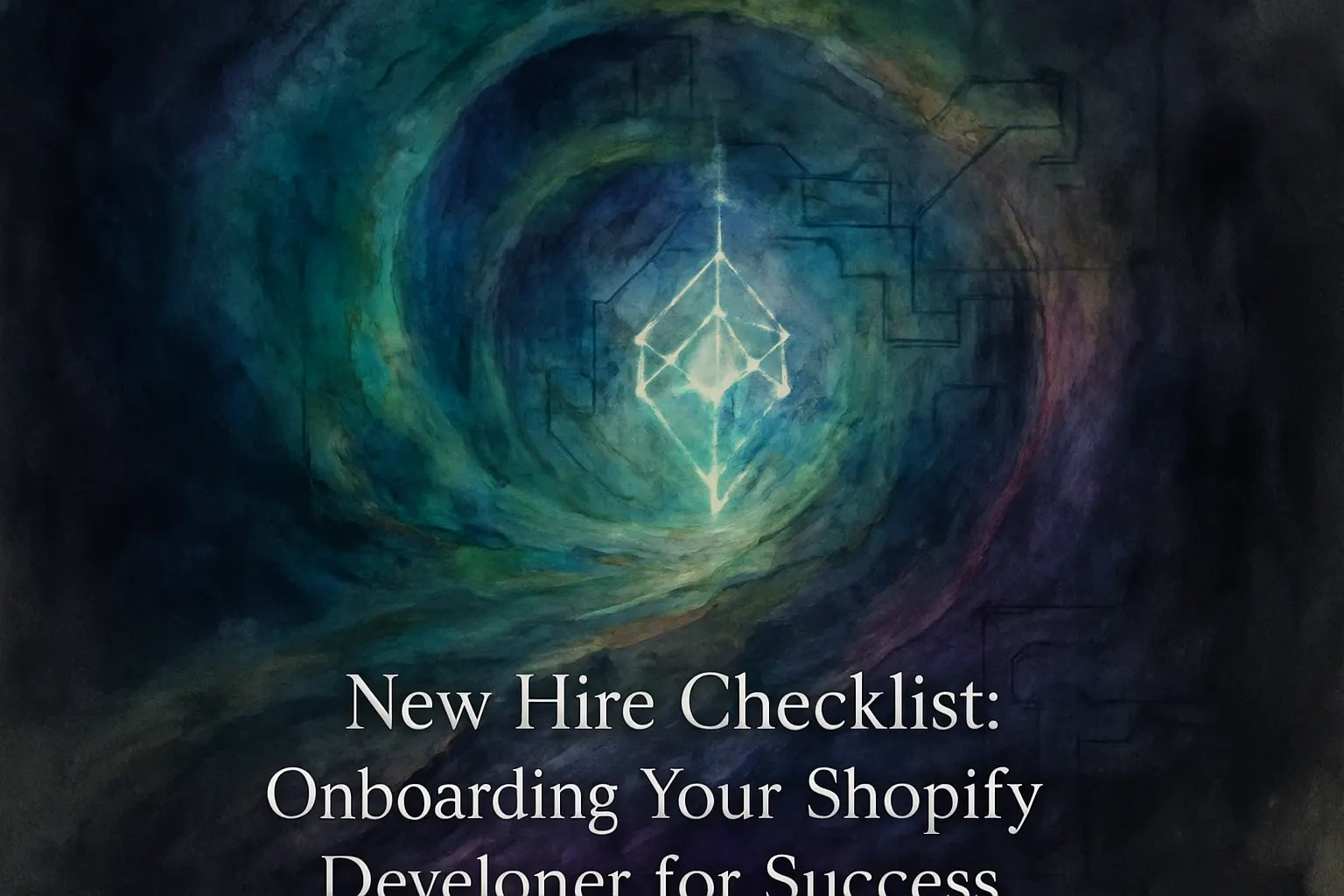
New Hire Checklist: Onboarding Your Shopify Developer for Success
Phase 1: Pre-Onboarding — Before the First Day
Complete All Necessary Paperwork
Grant Access to Essential Systems
Prepare a Welcome Kit
Phase 2: The First Week — Integration and Initial Tasks
Technical Environment Setup
Introduce Key Team Members
Assign a Small, Well-Defined First Task
Phase 3: The First Month — Aligning and Setting the Pace
Establish a Communication Cadence
Review the Project Roadmap and Goals
Conduct a 30-Day Review
Making Onboarding Work for Your Team
References
New Hire Checklist: Onboarding Your Shopify Developer for Success
A successful Shopify project begins with a successful onboarding process. A structured onboarding ensures your new developer integrates smoothly into your team, understands your goals, and becomes productive quickly. This checklist will guide you through the crucial first month.
A key part of this is clearly defining project goals, which involves setting expectations with your Shopify developer. To get started, you'll first need to hire a Shopify developer that fits your project's needs.
Phase 1: Pre-Onboarding — Before the First Day
The work begins before your developer officially starts. Proper preparation ensures they can hit the ground running. This phase is about handling administrative tasks and preparing the necessary access and tools.
Think of pre-onboarding like setting up a workspace before someone arrives. You wouldn't invite a guest over without preparing a place for them to sit, right? The same principle applies here. When everything's ready beforehand, your developer can focus on what they do best—building great Shopify stores.
Complete All Necessary Paperwork
Streamline the administrative process by getting all contracts and payment details sorted out beforehand. This includes the freelance agreement, NDAs, and tax forms like the W-8BEN for international contractors.
Nobody likes paperwork, but it's essential. Start by sending your freelance agreement at least a week before the start date. Include clear payment terms, project scope, and intellectual property clauses. For international developers, you'll need specific tax documentation. The W-8BEN form helps US companies work with foreign contractors without withholding taxes.
Don't forget about NDAs if your project involves sensitive business information. Some developers work with multiple clients, so protecting your data is crucial. Make these documents easy to sign digitally through platforms like DocuSign or HelloSign. This saves time and creates a paper trail.
Pro tip: Create a checklist of required documents and share it with your developer early. This prevents last-minute scrambling and shows you're organized and professional.
Grant Access to Essential Systems
Provide early access to communication tools like Slack, project management boards like Trello or Asana, and your company's knowledge base. This allows them to familiarize themselves with your workflows and team culture.
Start with communication tools. Send Slack invitations a few days early so they can set up their profile and browse public channels. This gives them a feel for how your team communicates. Add them to relevant channels but avoid overwhelming them with too many at first.
Next, grant access to your project management system. Whether you use Trello, Asana, or Monday.com, create their account and assign them to the right boards. Include a brief video or document explaining how you use these tools. Every team has its own style, and what seems obvious to you might be confusing to someone new.
Don't forget about documentation access. If you have a company wiki, style guides, or brand guidelines, share these early. Developers often like to review technical documentation before diving into code. This preparation time is valuable and shows respect for their process.
Prepare a Welcome Kit
A small welcome gesture can make a big difference, especially for remote developers. Consider sending a package with company swag, a welcome note, and a guide to the company's culture and values.
Remote work can feel isolating, especially in the beginning. A physical welcome package creates a tangible connection to your company. Include practical items like a branded notebook, quality pen, or even a coffee mug. These aren't just gifts—they're daily reminders that your developer is part of the team.
Add a handwritten welcome note from the team lead or founder. In our digital world, handwritten notes stand out. Keep it brief but personal. Mention something specific about why you're excited to work with them.
Include a culture guide that goes beyond the typical employee handbook. Share inside jokes, team traditions, or favorite virtual hangout spots. Maybe your team does virtual coffee breaks on Fridays or has a book club. These details help new developers feel included from day one.
Phase 2: The First Week — Integration and Initial Tasks
The first week is crucial for setting the tone. The focus should be on integration, understanding the technical environment, and tackling a small, manageable first task to build momentum.
This week is all about building confidence and connections. Your developer should finish the week feeling capable and excited about the work ahead. Balance information sharing with hands-on work. Too much theory without practice leads to information overload. Too much work without context creates confusion.
Technical Environment Setup
Schedule a session to walk through the Shopify store setup, theme files, app integrations, and the development workflow. Grant access to the Shopify Partner Dashboard, GitHub repositories, and any other development-specific tools.
Start with a live walkthrough of your Shopify store's backend. Share your screen and navigate through the admin panel together. Point out custom apps, third-party integrations, and any quirks in your setup. Developers appreciate knowing about technical debt or workarounds upfront.
Next, dive into the codebase. Walk through your theme structure, explaining any custom modifications or non-standard practices. If you're using a premium theme, mention which features you've customized. Show them where to find liquid templates, CSS files, and JavaScript modules.
Set up their development environment together. This includes GitHub access, local development tools, and deployment processes. If you use specific tools like Theme Kit or Shopify CLI, ensure they're installed correctly. Share any team conventions for branch naming, commit messages, or code reviews.
Important: Document this entire process. Future developers will benefit from having a written guide, and your current developer can reference it later.
Introduce Key Team Members
Organize brief introductory meetings with key points of contact—project managers, designers, and other developers they will be collaborating with. This helps build personal connections.
Keep these meetings short and purposeful. Fifteen to twenty minutes is plenty for initial introductions. Focus on helping people understand how they'll work together, not just exchanging pleasantries.
Start with the project manager or main point of contact. This person should explain communication preferences, meeting schedules, and how to escalate issues. They should also clarify decision-making processes. Who approves design changes? Who has the final say on technical decisions?
Schedule time with designers if your developer will implement their work. Designers can explain their process, preferred handoff methods, and how they document specifications. This prevents future miscommunication about design implementation.
If you have other developers, arrange a technical discussion. They can share coding standards, testing procedures, and deployment workflows. Peer connections often become the most valuable relationships for problem-solving and knowledge sharing.
Assign a Small, Well-Defined First Task
Start with a low-risk task, such as a small bug fix or a minor CSS adjustment. This helps the developer get comfortable with the codebase and your deployment process without the pressure of a major feature.
Choose a task that touches multiple parts of your workflow. A simple bug fix that requires finding the issue, making changes, testing, and deploying gives them hands-on experience with your entire process. Avoid tasks that are either too trivial or too complex.
Provide clear acceptance criteria. Instead of "fix the checkout button," specify "The checkout button should maintain consistent styling across mobile and desktop views, matching our design system colors." This clarity helps them succeed and shows how you communicate requirements.
Pair this task with a mentor or buddy who can answer questions. Make it clear that questions are encouraged. The goal isn't just completing the task—it's learning your team's approach to problem-solving.
Review their work thoroughly but kindly. Focus feedback on alignment with team standards rather than personal preferences. If they solve the problem differently than expected, discuss the trade-offs. This creates a learning opportunity for everyone.
Phase 3: The First Month — Aligning and Setting the Pace
During the first 30 days, the focus shifts to full integration, performance alignment, and establishing a rhythm for long-term collaboration.
By now, your developer understands the basics. This phase is about building momentum and establishing sustainable work patterns. You're moving from orientation to optimization, helping them find their groove within your team's workflow.
Establish a Communication Cadence
Set up regular check-ins, such as daily stand-ups or weekly syncs, to discuss progress, roadblocks, and priorities. This ensures continuous alignment and support.
Find the right balance for your team. Daily stand-ups work well for fast-moving projects but might feel excessive for longer-term work. Weekly syncs provide structure without micromanagement. The key is consistency—pick a schedule and stick to it.
Keep stand-ups focused and brief. The classic format works well: what you did yesterday, what you're doing today, and any blockers. For remote teams, consider asynchronous updates through Slack or project management tools. This respects different time zones and work styles.
Beyond regular meetings, establish communication norms. How quickly should they respond to messages? When should they escalate issues? What warrants an immediate call versus an email? Clear expectations prevent anxiety and miscommunication.
Create space for informal communication too. Remote developers miss water cooler conversations that happen naturally in offices. Consider virtual coffee chats or dedicated Slack channels for non-work discussions. These connections strengthen team bonds and improve collaboration.
Review the Project Roadmap and Goals
Go over the long-term project roadmap and the specific goals for the upcoming quarter. This provides context and helps the developer understand how their work contributes to the bigger picture.
Start with the big picture. Share your business goals and how the Shopify store supports them. Are you launching new products? Expanding internationally? Improving conversion rates? Developers make better technical decisions when they understand business objectives.
Break down the roadmap into manageable phases. Show them the next three to six months of planned work. Highlight dependencies, deadlines, and potential challenges. This transparency helps them plan their time and identify opportunities to add value.
Discuss technical priorities alongside business goals. Maybe you need to improve site speed before the holiday shopping season. Or perhaps mobile optimization is crucial for your customer base. Connect these technical improvements to business outcomes.
Involve them in planning discussions. Even in their first month, fresh perspectives are valuable. They might spot opportunities or challenges that your team has overlooked. This inclusion also increases their investment in the project's success.
Conduct a 30-Day Review
Schedule a feedback session at the end of the first month. Discuss what's working well, identify any challenges, and set clear goals for the next phase of their work. This is a two-way conversation to ensure both parties are aligned and satisfied.
Prepare for this conversation thoughtfully. Review their completed tasks, communication style, and integration with the team. Note specific examples of both successes and areas for improvement. Vague feedback helps nobody.
Start with positives. Acknowledge their accomplishments and the value they've already added. Maybe they solved a tricky bug or suggested a process improvement. Recognition motivates continued excellence.
Address challenges constructively. If something isn't working, discuss it openly. Perhaps they need more context before starting tasks, or maybe the communication style needs adjustment. Frame these as opportunities for mutual improvement, not failures.
Ask for their feedback too. What's working well from their perspective? What could make their work more effective? Are there tools or resources they need? Their input improves your onboarding process for future hires.
Set specific goals for the next month. These should be measurable and achievable. Maybe they'll take ownership of a specific feature or improve deployment times by 20%. Clear targets provide direction and motivation.
Making Onboarding Work for Your Team
Successful onboarding isn't just about checking boxes. It's about creating an environment where your new Shopify developer can thrive. Every team is different, so adapt this checklist to fit your culture and needs.
Remember that onboarding is an investment. The time you spend in these first 30 days pays dividends through improved productivity, better communication, and stronger team cohesion. A developer who feels welcomed and well-prepared delivers better work and stays engaged longer.
Keep refining your process. After each new hire, ask what worked and what didn't. Maybe your documentation needs updating, or perhaps the first task was too complex. Continuous improvement makes each onboarding experience better than the last.
Most importantly, treat your developer as a partner, not just a contractor. Share your vision, include them in decisions, and value their expertise. When developers feel like true team members, they bring their best ideas and effort to your project.
The first month sets the tone for your entire working relationship. Use this checklist as a starting point, but don't be afraid to add your own touches. The goal is simple: help your new Shopify developer succeed. When they win, your project wins too.
References
Like this project
Posted Jul 4, 2025
Set your new Shopify developer up for success from day one. Our comprehensive onboarding checklist covers everything from pre-boarding paperwork to the first month's goals.


